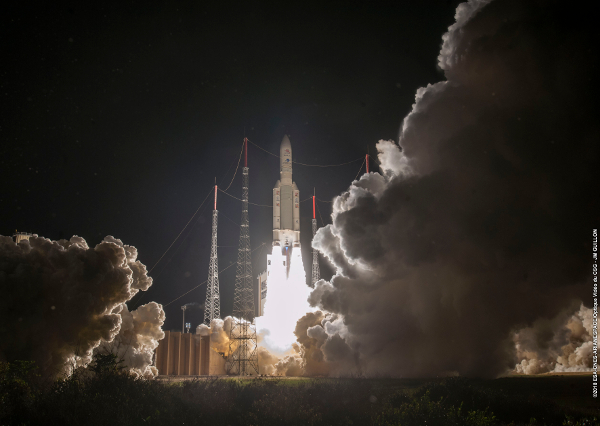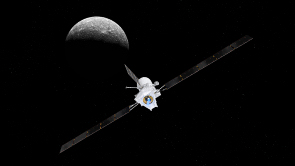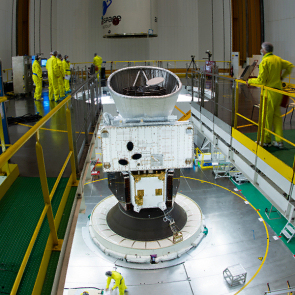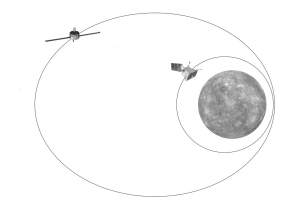ESA PR 28-2018: BepiColombo blasts off to investigate Mercury's mysteries
20 October 2018
The ESA-JAXA BepiColombo mission to Mercury blasted off on an Ariane 5 from Europe's Spaceport in Kourou at 01:45:28 GMT on 20 October on its exciting mission to study the mysteries of the Solar System's innermost planet. |
| BepiColombo liftoff. Credit: ESA/CNES/Arianespace/Optique vidéo du CSG – JM Guillon |
Signals from the spacecraft, received at ESA's control centre in Darmstadt, Germany, via the New Norcia ground tracking station at 02:21 GMT confirmed that the launch was successful.
BepiColombo is a joint endeavour between ESA and the Japan Aerospace Exploration Agency, JAXA. It is the first European mission to Mercury, the smallest and least explored planet in the inner Solar System, and the first to send two spacecraft to make complementary measurements of the planet and its dynamic environment at the same time.
"Launching BepiColombo is a huge milestone for ESA and JAXA, and there will be many great successes to come," says Jan Wörner, ESA Director General.
 |
| BepiColombo approaching Mercury. Credit: spacecraft: ESA/ATG medialab; Mercury: NASA/JPL |
"Beyond completing the challenging journey, this mission will return a huge bounty of science. It is thanks to the international collaboration and the decades of efforts and expertise of everyone involved in the design and building of this incredible machine, that we are now on our way to investigating planet Mercury's mysteries."
"Congratulations on the successful launch of Ariane 5 carrying BepiColombo, ESA-JAXA joint Mercury exploration mission," says Hiroshi Yamakawa, JAXA President.
"I would like to express my gratitude for the excellent achievement of launch operations. JAXA has high expectations that the ensuing detailed observations on the surface and interior of Mercury will help us better understand the environment of the planet, and ultimately, the origin of the Solar System including that of Earth."
BepiColombo comprises two science orbiters: ESA's Mercury Planetary Orbiter (MPO) and JAXA's Mercury Magnetospheric Orbiter (MMO, or 'Mio'). The ESA-built Mercury Transfer Module (MTM) will carry the orbiters to Mercury using a combination of solar electric propulsion and gravity assist flybys, with one flyby of Earth, two at Venus, and six at Mercury, before entering orbit at Mercury in late 2025.
| BepiColombo's journey to Mercury (click here to access the video and more details). Credit: ESA |
"There is a long and exciting road ahead of us before BepiColombo starts collecting data for the science community," says Günther Hasinger, ESA Director of Science.
"Endeavours like the Rosetta mission and their ground-breaking discoveries even years after their completion have already shown us that complex science exploration missions are well worth the wait."
The two science orbiters will also be able to operate some of their instruments during the cruise phase, affording unique opportunities to collect scientifically valuable data at Venus. Moreover, some of the instruments designed to study Mercury in a particular way can be used in a completely different way at Venus, which has a thick atmosphere compared with Mercury's exposed surface.
 |
| Ariane 5 fairing closure over the BepiColombo spacecraft stack. Credit: ESA - M. Pedoussaut |
"BepiColombo is one of the most complex interplanetary missions we have ever flown," says Andrea Accomazzo, ESA Flight Director for BepiColombo.
"One of the biggest challenges is the Sun's enormous gravity, which makes it difficult to place a spacecraft into a stable orbit around Mercury. We have to constantly brake to ensure a controlled fall towards the Sun, with the ion thrusters providing the low thrust needed over long durations of the cruise phase."
Other challenges include the extreme temperature environment the spacecraft will endure, which will range from -180°C to over 450°C – hotter than a pizza oven. Many of the spacecraft mechanisms and outer coatings had not previously been tested in such conditions.
The overall design of the three spacecraft modules also reflects the intense conditions they will face. The large solar arrays of the transfer module have to be tilted at the right angle to avoid radiation damage, while still providing enough energy to the spacecraft. On the MPO, the wide radiator means the spacecraft can efficiently remove heat from its subsystems, as well as reflect heat and fly over the planet at lower altitudes than ever achieved before. Eight-sided Mio will spin 15 times a minute to evenly distribute the Sun's heat over its solar panels to avoid overheating.
"Seeing our spacecraft blast off into space is a moment we have all been waiting for," says Ulrich Reininghaus, ESA's BepiColombo project manager.
"We have overcome many hurdles over the years, and the teams are delighted to see BepiColombo now on the road to intriguing planet Mercury."
 |
| BepiColombo orbits. Credit: ESA/ATG medialab |
A few months before arriving at Mercury, the transfer module will be jettisoned, leaving the two science orbiters – still connected to each other – to be captured by Mercury's gravity. Their altitude will be adjusted using MPO's thrusters until MMO's desired elliptical polar orbit is reached. Then MPO will separate and descend to its own orbit using its thrusters.
Together the orbiters will make measurements that will reveal the internal structure of the planet, the nature of the surface and the evolution of geological features – including ice in the planet's shadowed craters – and the interaction between the planet and the solar wind.
"A unique aspect of this mission is having two spacecraft monitoring the planet from two different locations at the same time: this is really key to understanding processes linked to the impact of the solar wind on Mercury's surface and its magnetic environment," adds ESA's BepiColombo project scientist Johannes Benkhoff.
"BepiColombo will build on the discoveries and questions raised by NASA's Messenger mission to provide the best understanding of Mercury and Solar System evolution to date, which in turn will be essential for understanding how planets orbiting close to their stars in exoplanet systems form and evolve, too."
For further information, please contact:
ESA Media Relations Office
Email: media![]() esa.int
esa.int
Tel: +33 1 53 69 72 99





